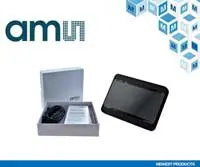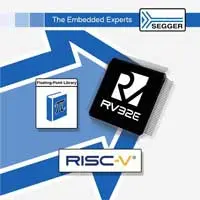Electronics News
Archive : 22 September 2020 год
 Mouser is now stocking the TMF8801-EVM evaluation kit from ams. The kit allows engineers to evaluate the operation of the ams TMF8801 1D time-of-flight (ToF) sensor for applications such as smartphones, industrial robotics, and autonomous appliances.
Mouser is now stocking the TMF8801-EVM evaluation kit from ams. The kit allows engineers to evaluate the operation of the ams TMF8801 1D time-of-flight (ToF) sensor for applications such as smartphones, industrial robotics, and autonomous appliances.
The TMF8801-EVM includes a ToF sensor enclosure and sample glass, USB type A to micro-USB cable, USB flash drive with EVM GUI software, and EVM documentation.
The onboard TMF8801 ToF sensor offers highly accurate depth accuracy detection through a sub-nanosecond light pulse and an anti-aliasing “stop-watch” method to measure round-trip time of the pulse. The TMF8801 provides single-zone detection of an object irrespective of the colour, reflectivity, and texture.
This single module with VCSEL emitter offers high dynamic range and detection sensing measurements with a 20 mm to 2500 mm distance range. It utilises highly sensitive single-photon avalanche diode (SPAD) detection with fast compact time-to-digital converters to make highly accurate distance measurements within ±5 percent and is capable of operation in both dark environments and in the presence of sunlight.
Measuring 2.2 mm × 3.6 mm × 1.0 mm, the TMF8801 is more than 30 percent smaller than other ToF sensors on the market, making it suitable for compact, space-constrained designs in applications such as laser detect auto-focus (LDAF), presence detection, industrial ranging, object and collision avoidance, fast ranging navigation detection, and inventory control.
Author
Neil Tyler
Source: www.newelectronics.co.uk
 Qualcomm Technologies has announced a new 5G mobile platform in the 7-series, the Qualcomm Snapdragon 750G 5G Mobile Platform.
Qualcomm Technologies has announced a new 5G mobile platform in the 7-series, the Qualcomm Snapdragon 750G 5G Mobile Platform.
The Snapdragon 750G has been designed to enable, what Qualcomm describes, truly global 5G with enhanced HDR gaming and impressive on-device AI. To date, there have been more than 275 designs announced or in development based on the company's Snapdragon 7-series mobile platforms, including 140 5G designs.
“We continue to see great traction with our high-tier Snapdragon 7-series 5G mobile platforms,” said Kedar Kondap, vice president of product management, Qualcomm Technologies. “As we continue to build out this relatively new tier of our mobile roadmap, we’re always looking for ways to support the growing needs of our OEM customers. Snapdragon 750G delivers a selection of premium mobile features to an even wider audience.”
The Snapdragon 750G features the Snapdragon X52 5G Modem-RF System, which supports both mmWave and sub-6 GHz, SA and NSA modes, TDD, FDD and Dynamic Spectrum Sharing (DSS), and global roaming and global multi-SIM.
This modem-to-antenna solution allows devices powered by Snapdragon 750G to support multi-gigabit connections with lightning-fast upload and download speeds.
The Snapdragon 750G offers select Snapdragon Elite Gaming features to allow for smooth, low-latency gameplay for richer entertainment quality. Equipped with the Adreno 619 GPU, the Snapdragon 750G enables up to 10% better graphics rendering compared to the Snapdragon 730G. In addition, players can take advantage of 5G through multiplayer gaming or streaming games directly to their smartphones with up-and-coming 5G cloud gaming platforms.
Featuring the latest 5th generation Qualcomm AI Engine, the Snapdragon 750G is able to support smart camera and video, voice translation, advanced AI based imaging, and AI enhanced gaming experiences. With up to 4.0 Trillion Operations Per Second (TOPS), the AI Engine delivers up to 20% improvement compared to the Snapdragon 730G.
The Snapdragon 750G also features the Qualcomm Kryo 570 CPU, which delivers up to 20% improvement compared to Snapdragon 730G. It is also equipped with the always-on Qualcomm Sensing Hub, which combines multiple data streams for contextual use-cases: a low-power Qualcomm AI Engine enables AI-based echo cancellation and background noise suppression to provide improved voice-chat gaming experiences, uninterrupted voice communication, and support for always-on voice assistants.
Commercial devices based on the Snapdragon 750G are expected to be available by the end of 2020. Snapdragon 750G is also pin-and software-compatible with the Snapdragon 690 5GMobile Platform.
Author
Neil Tyler
Source: www.newelectronics.co.uk
 SEGGER has announced added support for the RV32E embedded processor core to its RISC-V floating-point library, which currently supports RV32I.
SEGGER has announced added support for the RV32E embedded processor core to its RISC-V floating-point library, which currently supports RV32I.
According to SEGGER this new library will lead to a significant reduction in code size for RISC-V applications using floating point.
With all arithmetic functions hand-coded in assembly language, the memory footprint of RISC-V applications using floating-point code is significantly reduced. The Floating-Point library complies with the RISC-V ABI standard and can be used as a plug-and-play replacement for any other floating point library.
Replacing the GNU floating-point library used by most toolchains with the SEGGER assembly optimised equivalent results, according to SEGGER, in a 72% code size reduction of the benchmark application. The library supports RV32I, as well as the newly introduced RV32E embedded variant of the RISC-V core with the assembly-level code.
"This new release is much smaller than anything available to us for comparison and, at the same time, is incredibly fast,” said Rolf Segger, Founder of SEGGER. "In the world of Embedded Systems, every byte counts. The SEGGER Floating-Point library delivers high performance and uses the architectural advantages of RISC-V to close the code-density gap to comparable Arm Cortex devices.”
The library can be licensed by end customers and toolchain suppliers.
As with the SEGGER Runtime Library, it is integrated into SEGGER Embedded Studio for RISC-V. Using Embedded Studio, benchmarking for both floating-point and runtime libraries can be done quickly and easily. It is readily available at no cost for non-commercial usage under SEGGER’s Friendly License.
Author
Neil Tyler
Source: www.newelectronics.co.uk

